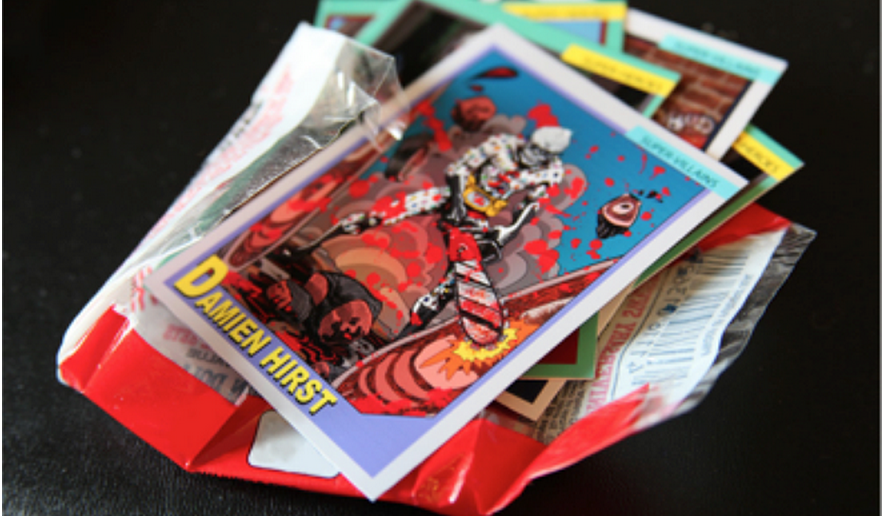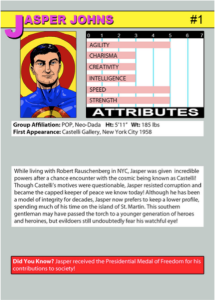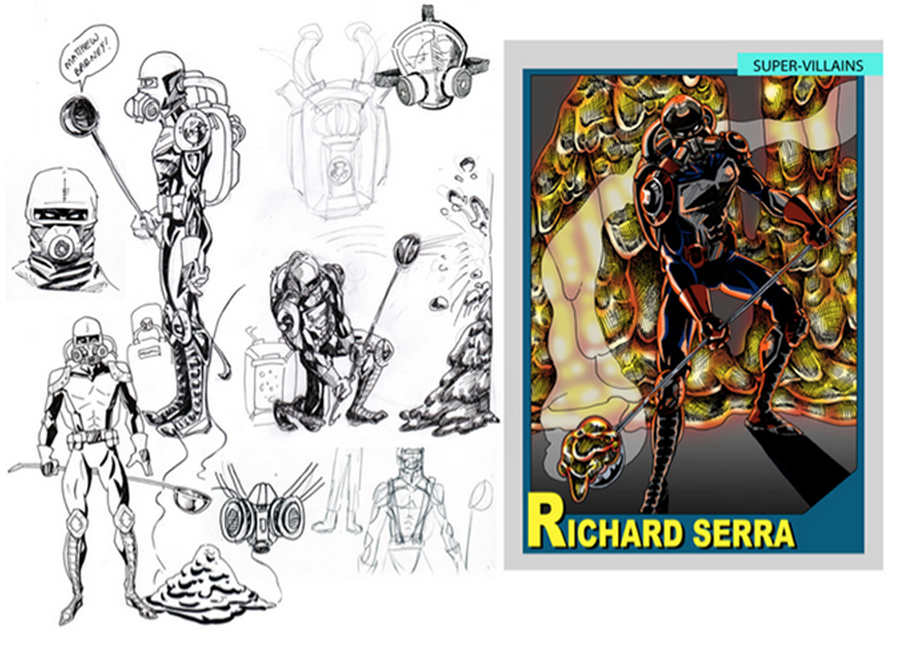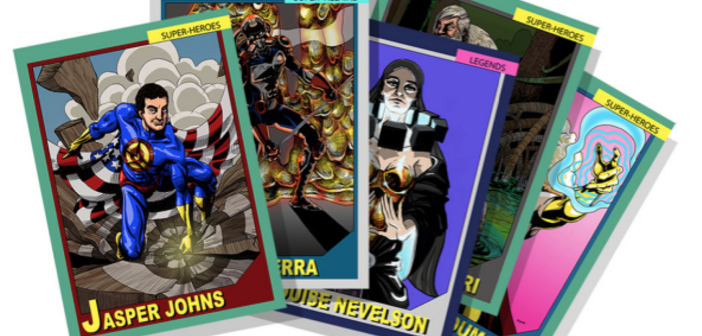It has been a project years in the making, and finally their idea has taken shape. Drawing inspiration from the iconic Marvel Universe cards, the set of 30 Art World Universe trading cards depicts contemporary artists including 12 heroes, 12 villains, and 5 legends. Although in the process of getting the cards fully funded, this project deserves a level of attention and recognition for its originality. So before their first series is distributed, I spoke with the artists responsible for these fantastical art characters to gain more insight into their collaboration and their art world.
Polina Isurin: How did this project start? How long have you been working on it?
Cody Justus: The project started in graduate school when I had the ridiculous idea of turning contemporary artists into heroes and villains. But I didn't have the skills to do it on my own. Left to my own devices and years later, only 3 cards would exist: Jasper Johns and Damien Hirst, designed more or less the same way as they are now but drawn 50 times worse, and one extremely offensive depiction of Jeff Koons.
Samara Pearlstein: He was talking about it with me all the time, and I thought it was funny, and made sense, but more importantly, I actually had the ability to draw these characters more or less how we pictured them.
PI: How did you decide on the characters?
SP: Well, first we decided on the criteria: they had to still be alive, and they had to be at a certain level—I think "museum-caliber artist" was the way we put that. So everyone is a public figure.
CJ: I had a list of about 50 white guys.
SP: We had to have a few sessions ripping that apart and thinking about who we actually cared about in the art world, not just white guys the art world's primed you to think about first.
PI: Who gets to be a hero or villain? What makes the "legends" different?
CJ: I think that's part of a larger epistemological question—who gets to be a hero or villain.
SP: It was pretty subjective. Some of them we agreed on immediately—it was obvious that Jasper Johns was a hero, and Damian Hirst was going to be a villain—but there were some differences of opinion. A few had to be compromises: if I got to say this person was a hero, Cody got to make this other person a villain.
CJ: The legends are dead artists in the same way that Marvel legends are—dead or in some state of suspended who-knows-what.

Art World Universe set of 30.
View of open pack with Villain Damien Hirst featured front and center. Image courtesy of the artists.
PI: How does your collaboration work? Who does what?
CJ: After we know who we're going to do, and what they're going to be [hero or villain], we go back and forth on a bunch of design sketches, costume sketches, powers, objects—like a bird, or chainsaws—that kind of stuff.
Then after we're happy with all of that, I [or Sam's former roommate Amy R.]pose for the reference, and Sam makes a drawing. Sometimes the characters inform the backstory, sometimes the backstory informs the character or costume. Sometimes someone is just actually a sasquatch, or a balloon animal.
SP: Yeah, I do all the final drawing—pencils and inks on paper, then digital colors. Cody writes the backstories, although I veto stuff that needs to be vetoed. We figured out the digital layouts together but Cody does that.
PI: Does working on the cards take time away from your art practices and how does it influence your personal projects in any way?
SP: It does, and this is part of why we've been working on this for so long. We had to take some time off from it to do our MFA thesis work—our work there was really different from this, and Cody's thesis was also very different from my thesis. I don't know if it has directly influenced our separate practices, but I do think getting really comfortable working with one another has improved both our studio practices. We can talk to each other productively about our individual work all the time.
PI: It is undeniable that these cards have an educational component to them. What are your thoughts on this project being a commentary on how we view contemporary art/art history?
CJ: I think these days people have more access to art knowledge than ever before, but that doesn’t make them knowledgeable about art. You don’t have to go trolling around some library looking for books that nobody has. You can just read art blogs on your phone. I wouldn’t say that we’re trying to provide any real educational tool. But the astute might find something out.
SP: I mean, they do have a lot of information in them—that’s part of what trading cards do, they convey a lot of information succinctly. And humor is one of the best ways to teach this stuff, in my opinion, anyway.
PI: Where do you see this project going?
CJ: After the cards get made, first and foremost they'll be a sort of novelty item for sale on the internet and in other local places—comic book shops, bookstores, whatever. There may also be an actual gallery show of some kind—that's something we've been thinking about. We have objects, images, video, and it would make sense in a gallery.
SP: It would be really funny, but it would be a kind of institutional critique, which is a Real Thing.
We'd like to maybe do a Series Two at some point-- we already have some other characters in the works.

Backs of cards feature attributes including agility, charisma, creativity, intelligence, speed and strength. A short bio along with a Did You Know section combines factual information on the artist with pure imagination. Featured card: Hero Jasper Johns. Image courtesy of the artists.
PI: Is institutional critique an avenue you are trying to avoid or that interests you? Perhaps the fact that you are looking to distribute the cards first rather than exhibit them as artworks in a gallery speaks to that question.
SP: I think institutional critique is inherent in the project—we’re making fun of the art world and its denizens, so that comes with the territory, right? At the same time, a lot of this comes out of our obsession with and love of that same art world. So I guess that if it is institutional critique, it’s at least not uncomplicated.
This project could exist equally well as trading cards, or as art objects. It really just depends on context and I suppose preference of the viewer? If you wanted to put them in plastic sleeves and display them—go for it, that’s what you do with trading cards. But it’s also a way to protect and display them in a gallery setting, if someone with a gallery wants to let us do that.
CJ: I mean, for the most part, the cards are pretty autonomous. They don’t really need us specifically. I would hope that people would be into the cards in pack form, or in a gallery setting; I think they would be interested in them based on the project itself, not necessarily because they know us, or like collaborative art, or any of that.
The people who are interested in the project just think that it’s cool. I think people will like the project—it’s not just for a certain kind of people, it’s not just for comic book people, and it’s not just for people who go to galleries and look at art. It’s the same reason you go watch Avengers when the movie comes out, it’s because you want to see an entertaining movie, not necessarily because you read every Avengers comic as a kid. Those movies are geared towards a broad demographic, not just comic book nerds.
Although those people also go see the Avengers movie. So yes, if you love the art world to a nerd level, I would think you’d find our project pretty interesting and funny.
SP: And that’s definitely us: we’re those nerds.

Examples of Art World Universe cards.
Currently a working artist, John Baldessari is featured as one of the Super-Heroes. Louise Nevelson, who is no longer living, is in the celebrated category of Legends. Images courtesy of the artists.
PI: Who is your favorite character?
CJ: All of them. They're like children to me.
PI: In that case, if you could be attacked and killed by any of the characters, which one would it be, and how?
CJ: Well, I'd like to say I would be bisected by Damien Hirst's chainsaw and suspended as some sort of formaldehyde trophy for everyone to see, but seeing as how in truth I'd probably definitely be a villain in this world, I'd probably be killed by... huh, I don't know. I guess I'd like to be dissected and preserved by Damien Hirst but it's much more likely that a Richard Serra piece just falls on me as I'm walking by.

Art World Universe sketches used in the process of creating Super-Villain card Richard Serra. Images courtesy of the artists.
PI: If you were a character in Art World Universe, what character would you be?
SP: I would have the power to communicate with cats. I guess I would be a hero, because cats are a force for good.
CJ: I'd just be myself, but a villain… guess that would make me some kind of evil truck driver?




